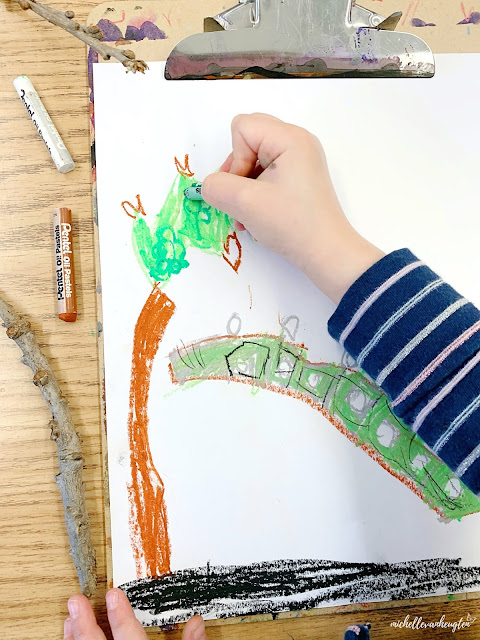"𝐼𝓃 𝒶𝓁𝓁 𝓉𝒽𝒾𝓃𝑔𝓈 𝑜𝒻 𝓃𝒶𝓉𝓊𝓇𝑒,
𝓉𝒽𝑒𝓇𝑒 𝒾𝓈 𝓈𝑜𝓂𝑒𝓉𝒽𝒾𝓃𝑔 𝑜𝒻 𝓉𝒽𝑒 𝓂𝒶𝓇𝓋𝑒𝓁𝑜𝓊𝓈."
𝒜𝓇𝒾𝓈𝓉𝑜𝓉𝓁𝑒
Children’s connections to the natural world inspire many of our inquiries and wonders within the learning environment. Developing the relationship children have with nature begins the moment they step outside. As children experience the joy and wonder of the ever-changing outdoor environment their senses are activated. When children are allowed to engage in daily explorations outdoors we begin their journey and support their sense of being within the world.

The children often bring in nature’s treasures to the indoor learning environment. Whether from their investigations during recess or when we are at play in the outdoor classroom each afternoon. Recently, the children have taken an interest in collecting the sticks that have fallen from the large trees within the schoolyard. Many of the trees are beginning to show signs of bud growth and this is of particular interest to the children. Their questions focus on the bumps and markings that they have observed on the sticks they collected.
We have allowed the children to develop their theories and ideas about what these bumps might be. Supporting them through the creative arts and using visual art materials in looking closely and recording their observations through drawing. The children were first offered oil pastels as they considered the branches. Their observations focused on the cracks in the bark and the bumps (buds).
The children’s theories and observations were shared during the creative process of drawing the sticks and during our gathered meeting times.
“There would have been branches on the bumps but people could have took them off. They were growing but and then they pulled the branches off.”
“The trees always make the sticks grow really big. The branches get bumpy and then the bump gets smoother.”
“Leafy, there’s a bud in there. There’s a leaf in it growing.”
“It can be a little house for buds. It looks kind of leafy and looks like a flower.”
“The flowers were falling off the tree and the branches. I feel that the branch came off the tree and no one thought of that.”
“This is an interesting stick. Imagine if these were all together and so giant. This one is so cool it has bumps. If all of these were together with all the big sticks it would be giant. It’s getting gianter.”
“I made it colourful. It looks pretty. I tried to trace the stick. It got messy. I did something else with a new stick. I traced it. I have a sun too. It’s really hot cause in the summer. When it’s summer the leaves start to grow. Then when it’s winter the leaves fall off the trees cause it’s too cold they die. Then when it comes back to summer the leaves grow again.”
“I was thinking when it was really strong then the wind. I think it blowed off and over the fence and bounced off the ground and hit the grass.”
The second creative offering to the children was the sticks with the medium of charcoal. When children revisit and reconsider and reflect on their previous ideas and observations new learning can take place. Charcoal offered a new experience as the children learned about it’s properties with respect to the sticks. When materials are in relationship with a subject matter our own understandings of what we are observing are deepened.







Several storybooks along with the Trees of North America research guide were also offered to the children. They continue to gather information from the images and ask questions as we share and use these books in conjunction with our stick collection. We are following the lead of the children and allowing them time and materials to process their thinking and wonders about the sticks. How exciting it will be when the spring weather arrives and the first few signs of growth on the trees emerges for the children to observe. Until then we will continue to wonder, create theories and share our ideas with each other creatively.
If you would like each blog post delivered right into your inbox become a blog subscriber. We would be honoured if you joined our creative community.
❤️
𝑀𝒾𝒸𝒽𝑒𝓁𝓁𝑒
























Comments
Post a Comment